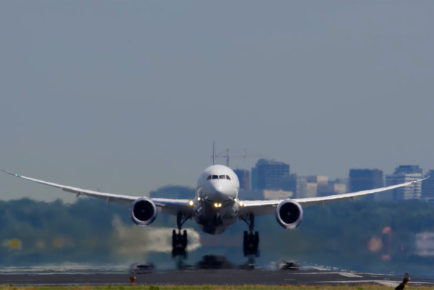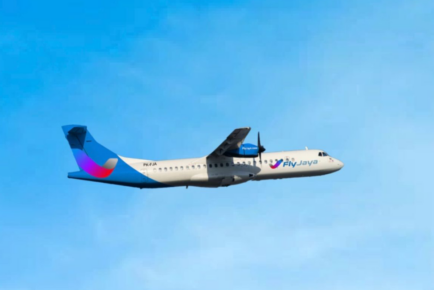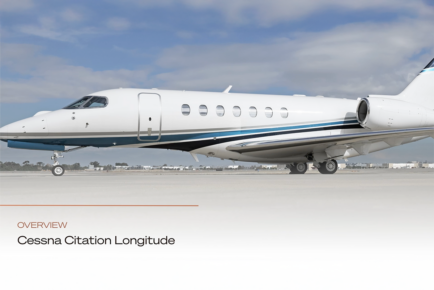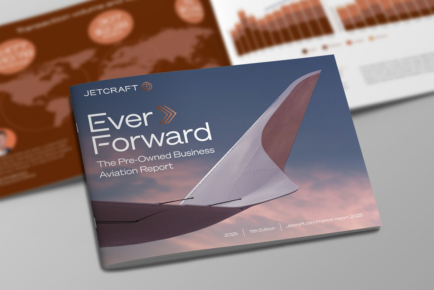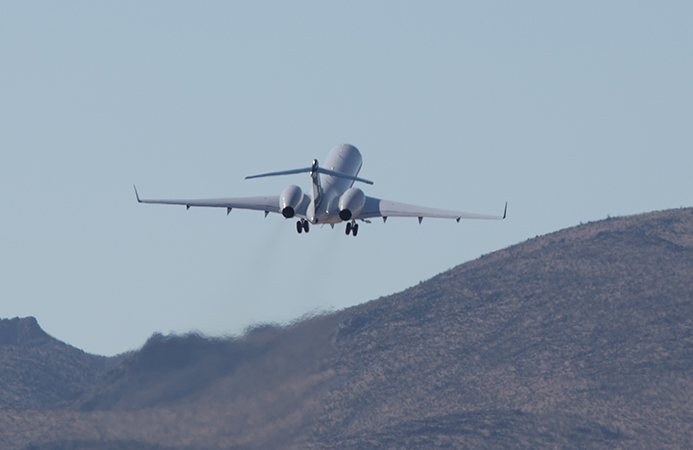
What Will It Involve?
World Aircraft Sales, March 2014
by Ken Elliott
Download a PDF of the article.
Much has been written regarding ADS-B, so the focus of this article is Automatic Dependent Surveillance Broadcast (ADSB) for business jets, what that will involve, and where to find the relevant information.
Most business jets today are well equipped with avionics, but are short on real estate to add more. Depending upon where you operate, however, the need to add data com, PBN and ADS-B is a necessary reality.
If your aircraft is new there is a good chance it is adequately equipped for ADS-B and – short of possible software updates – may well be operationally ready at least for ADS-B Out. For aftermarket business jets, however, the readiness for ADS-B is a very different story. ADS-B on the aircraft side touches a number of existing avionic systems, and Table A (see PDF download) highlights those systems and outlines why they are needed.
Because ADS-B requires an STC or TC for jet aircraft upgrades, the equipage needs highlighted in the table will be addressed by the certification documentation, and therefore should be verified by an MRO or the aircraft OEM. Accessible FAA and EASA guidance for equipage and operations can be found in:
• FAA AC 20-165A (ADS-B Out)
• FAA AC 20-172A (ADS-B In)
• FAA AC 20-149A (FIS-B)
• FAA AC 90-114 (ADS-B Ops as well as InFO 13009 for Ops Specs and LOA)
• EASA AMC 20-24 (ADS-B Certification Considerations. Many countries outside of EU use this standard).
Table B (see PDF download) depicts the different pathways for ADS-B compliance, and that for business jet operators TIS-B is a must. You’ll also see that having free FIS-B weather and data (such as providing ATIS and NOTAMS is a feature worth adding).
ADS-B Out provides GPS-derived position and other data via the transponders from aircraft-to-aircraft, aircraft-to-ground vehicles and to ATC. ADS-B In allows an aircraft to see other broadcasting aircraft while receiving ATC and ground transmitted information including traffic, weather and advisories. The Traffic Information Service Broadcast from ATC is called TIS-B. The free weather information provided and customized to an aircraft’s geographic location is available only via the Flight Information Service of FIS-B.
For a complete business jet solution, the aircraft needs to be equipped for both extended squitter 1090ES transponders and a separate UAT 978 MHz FIS-B In system. ADS-B Out needs to broadcast information derived from the transponder(s) themselves, aircraft IRS, air data and FMS/GPS systems. Think of the transponders broadcasting Identity, 3D Location, Velocity, Height and Optional Heading that together provide present and future trend of one aircraft to another, as well as to (and rebroadcast from) ATC.
When the TCAS II is version 7.1, imagine also each aircraft as a mini ATC radar monitor with the capability of displaying other aircraft (TCAS II and ADS-B derived with ID and trend data and non-ADS-B targets via TIS-B). The crew of a fully ADS-B equipped aircraft has significant situational awareness. Along with Radar, WAAS-LPV, TAWS and EFVS equipage, the aircraft is situated with respect to other aircraft, terrain, runway, weather and all-in low visibility conditions!
The big thing with ADS is the ‘effective total coverage and depth of information shared’ replacing existing ground radar while covering areas not previously served by ground radar. This is further enhanced with ADS-C – see ‘Some Further Explanations’ (below). A business jet equipped with ADS-B and -C will effectively operate with ADS-B coverage from the US into oceanic and on to Europe, for example, having radar-like coverage or situational awareness from start to finish.
DISPLAYS (ADS-B IN & FIS-B)
While not a requirement, the usefulness of ADS-B In is important to mention even though it is understood that many business jets today have subscription services for weather and ATIS. ADS-B In is still being defined but be assured that it eventually will include more than is available today and those who equip will be one step closer to any future requirements.
While new aircraft have video compatible instrument panel displays providing headsdown capability to display externally derived graphical information, many aftermarket jets do not have this panel-based capability. Typically aftermarket aircraft rely on Electronic Flight Bags (EFBs) and other forms of display monitoring.
ADS-B with FIS-B data can be displayed across many display formats including Class 1, 2 or 3 flight displays and tablets. You should, however, check STC and TC requirements for your aircraft type, in case the limitation of display is Class 3 only. To reiterate, most business jets will not have 978 MHz UAT equipage today, but by adding it as part of the ADS-B STC or TC, you will provide to the flight crew several free FIS-B In data, including:
• Aviation Routine Weather Reports (METARs)
• Non-Routine Aviation Weather Reports (SPECIs)
• Terminal Area Forecasts (TAFs) and their amendments
• NEXRAD (regional and CONUS) precipitation maps
• Notice to Airmen (NOTAM) Distant and Flight Data Center
• Airmen’s Meteorological Conditions (AIRMET)
• Significant Meteorological Conditions (SIGMET) and Convective SIGMET
• Status of Special Use Airspace (SUA)
• Temporary Flight Restrictions (TFRs)
• Winds and Temperatures Aloft
• Pilot Reports (PIREPS)
• Other ATIS information.
An ideal aircraft MFD display environment will include switchable source data from navigation, existing radar, enhanced vision, TCAS II – Transponder ADS-B targets, TIS-B and ADS-B equipped targets, terrain, and all the FIS-B data listed. More enhancements for display of data are forthcoming.
SOME FURTHER EXPLANATIONS
ELS v EHS Transponders: When reviewing your extended squitter 1090ES transponders, you may come across either Elementary or Enhanced Surveillance versions. ELS (Elementary), provides a flight identification number, while EHS (Enhanced) provides more detailed position and trajectory data. The STC for any specific ADS-B solution will call out the minimum version required while EHS is preferred.
ADS-B v ADS-C: Broadcast (-B) and Contract (-C) defines the difference between ADS-B and -C. The transponder broadcasts data for ATC and other aircraft, while for oceanic purposes the aircraft contracts using the Satcom. ADS data is relayed to international ground centers of operation via satellite and then broadcast to other aircraft. There are in fact three types of contract: ‘Periodic’, ‘Event’ and ‘Demand’. Periodic is required by ATC; Event is deviation from assigned course, and Demand is for emergency contact.
ADS-R: This is where 978MHz UAT and 1090MHz ES broadcasts are rebroadcast in the opposite format so that both Part 23 and 25 ADS-B In capable aircraft will ‘see’ these aircraft.
TIS-B: Today TIS-B provides radar-derived data regarding non ADS-B equipped aircraft, so in essence ‘filling in the gaps’ for total aircraft situational awareness. TIS-B service is limited to those targets within 15 mile range at +3,500 ft of a receiving aircraft.
TCAS 7.1 Hybrid Surveillance: Hybrid Surveillance reduces the interrogation rate of aircraft and ground transponders freeing up the 1090MHz band for improved TCAS traffic operation in high volume airport, terminal or en route environments.
WHY IS ADS-B A BENEFIT?
Following are some general pointers outlining the benefits to operators having ADS-B:
• The more users there are the more benefit, because more data becomes available to automatically share.
• ADB-B provides for Continuous Descent Approaches (CDAs) or Optimal Profile Descents (OPDs), In-trail tracking, and other airspace op advantages.
• Real-time traffic is available in the cockpit at an effective range of greater than 100 miles (although TIS-B is only 15 miles).
• Traffic avoidance with both lateral and vertical guidance.
• Coverage is available in remote areas that do not currently have ground radar.
• Reduced separation and greater predictability in both departure and arrival times.
• Further enhancements are due, including surface features such as warnings of imminent runway incursion.
UPGRADE CONSIDERATIONS
So why should an operator upgrade now rather than later? All those who remember the difficult days of complying to TAWS, TCAS and RVSM mandates a decade ago will undoubtedly appreciate the advantages of equipping well ahead of the deadline dates already in place in Australia, for example. Other good reasons to upgrade now include:
• Downtime would be much shorter today than nearer EU and FAA deadlines as scheduling, over-booking and full hangars will dictate timing, slots and prioritization.
• Costs to do so will increase nearer the deadline dates as demand increases and OEM/MRO schedules fill to capacity.
• Certification times for STCs, TCs and approvals will dramatically extend as demand picks up and the same trained or experienced personnel are assigned more ADS-B projects.
For aftermarket aircraft the integration requirements for ADS-B are more likely to be analogue- and not digital-based, making the process more engineering and resource intensive. Upgrades pertaining to ADS-B may involve multiple certifications such as TCAS II 7.1, ADS-B Out and then ADS-B In including FIS-B and its display. Legacy aircraft, even of the same type may have different certification options based on existing equipage, that we all know can vary. In the case of TCAS II 7.1, the mandate dates differ to ADS-B. ICAO mandates forward-fit in 2014 and retrofit for 2017, while EASA mandated forward-fit back in 2012 and retrofit for 2015.
Sensible planning could incorporate both TCAS and ADS-B upgrades at the same time particularly as they both involve STCs or TCs. The TCAS STC or TC may only be an amendment to an existing, but still formidable exercise in today’s certification world. Meantime, while mandates are up and coming, ground stations for ADS-B are already in place in a number of areas including the US, so the infrastructure is ready to use. Refer to ‘ADS-B Useful Resources’ (below) for links to individual country and regional ADS-B mandate dates.
Specifically for upgrade of aftermarket aircraft new innovative products are emerging, adapting to or filling-in the equipage gaps where (for example) FMS/GPS requirements are not met, or there is a desire for FIS-B In data. One such device by Freeflight serves just this purpose. The low cost RANGR P25 avoids the need to fully reequip. It does, as with other solutions, require the addition of new antennas which, for some aircraft, could imply extensive interior access. Freeflight, incidentally, also offers great introductory training at http://adsbuniversity.com/ads-b-university.
ADS-B & TRADING AIRCRAFT
When considering an aircraft trade – either buying or selling – you should review the following primary ADS-B considerations:
• Transponders: Do they comply for ADSB Out as well as EU/ICAO transponder requirements?
• FMS/GPS: Do they meet TSO requirements for ADS-B while meeting both Oceanic and EU/ICAO?
• RNP needs and the proper GPS position data source to interface to the transponders?
• Do you have a display capable for all the ADS-B needs and do you want to include FIS-B data?
• Do you wish to have the free FIS-B service?
• Should you include ADS-C, or at least the capability to add it later at minimal cost?
• Is the TCAS II a version 7.1?
• For all of the above, are there STCs or TCs available today?
Shop around for solution options and upgrade paths. Look for ways to do as much work at the same time – especially where access is required as this reduces downtime and cost. Look to bundle work across NextGen technologies such as WAAS-LPV, RNP, EFVS and Data Com using the resource of the new US-based NEXA CAPITAL financing. Low interest rates are available for NextGen technologies as part of a new alliance between government and industry. See the AEA website for more information: www.aea.net.
Buying a compliant aircraft eliminates the headache later, and it is far easier to sell a one-price compliant aircraft that may cost more than a non-complaint one with a host of unknown costs to follow!
ADS-B USEFUL RESOURCES
A great place to start for ADS-B Intel is the Aircraft Electronics Association (AEA) a worldwide body representing the interests of avionics manufacturers, dealers and installers.
On AEA’s website are several very useful links to ADS-B information, familiarization and training. Visit: www.aea.net/ads-b/.
Last – but certainly not least – is the reliable and trusted NBAA with in-depth worldwide operational data as a service to its members (www.nbaa.org).
❯ Ken Elliott is an avionics veteran of 40 years and more recently focused on NextGen. His work within the NextGen Advisory Council subcommittee brings him close to current and intended development effort. Equally, his specialization in low-vision operations provides a deeper insight into one of the pillars of NextGen. Ken has served the aviation industry on three continents from light GA to large corporate aircraft. His current employer, Jetcraft, is a leading aircraft brokerage company with worldwide presence. ❯ More from www.www.jetcraft.com, email: [email protected]
SIGN UP FOR OUR MONTHLY JETSTREAM RECAP
Don't miss future Jetstream articles. Sign up for our Jetcraft News mailing list to receive a monthly eblast with links to our latest articles. Click to join the 1,800+ subscribers on our mailing list.
